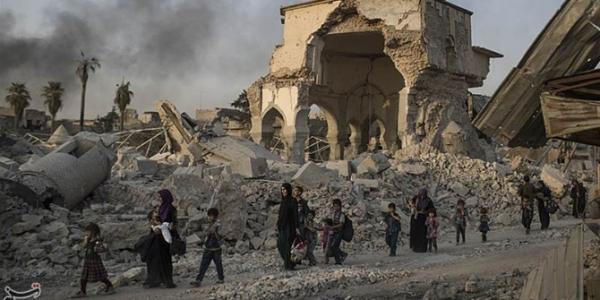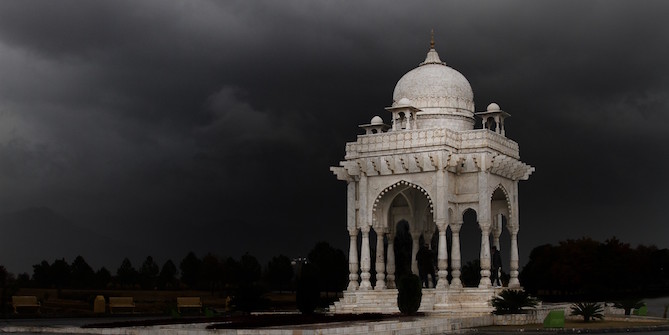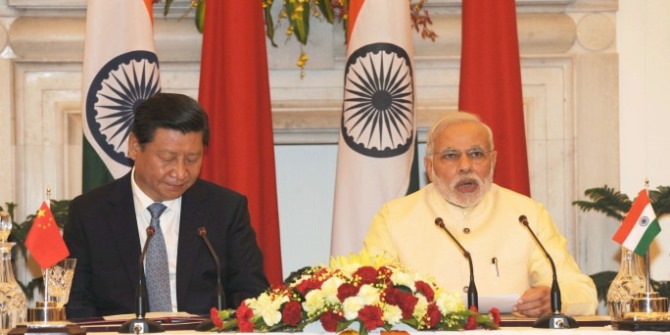 With the liberation of Mosul, the dream of IS to build an actual ‘Islamic state’ is being decimated. However, the remnants of the group, for seeking time and space to reorganise themselves, may flee to remote areas. The chances of a return should not be ruled out, writes Muhammad Suleman
With the liberation of Mosul, the dream of IS to build an actual ‘Islamic state’ is being decimated. However, the remnants of the group, for seeking time and space to reorganise themselves, may flee to remote areas. The chances of a return should not be ruled out, writes Muhammad Suleman
Finally, Islamic State’s fighters are near to total defeat in Syria and Iraq. First, they lost Mosul —Islamic State’s former de facto capital in July this year and now they have lost Raqqa. Just three years back in 2014, the ISIS supreme leader Abu Bakr Al-Baghdadi emerged from the pulpit of the Great Mosque of Al-Nuri in Mosul and delivered a sermon to his followers as the new caliph. Upon this, up to 30,000 Jihadists from all over the world travelled to Syria to join the IS’s hands. During ISIS’ occupation of Mosul, the city remained a significant pillar of the group’s organisational structure and therefore remained strategically vital. Since the initiation of war by US and Russian led coalition forces against Daish militants, the terrorist organisation has lost a major part of its territory and is still struggling to defend the remaining few areas of its caliphate with significant jihadi manpower. Moreover, it has lost more than sixty thousands militants including 25000 foreign fighters since 2014. With the liberation of Mosul, the dream of IS to build an actual ‘Islamic state’ is being decimated. Having said that, the remnants, for seeking time and space to reorganise themselves, may flee to remote areas. The effectiveness of the group’s dissemination among different radical groups across the globe implies that the chances of its growing back cannot be ruled out.
Ostensibly, the defeat of IS from the surface seems firm but its members would likely opt for underground resistance—‘ISIS 2.0’. The surviving militants are likely to prefer moving toward unstable areas and the so-called declared wilayas (provinces) so that they could regroup themselves safely. However, the major challenge that still lurks is of the foreign fighters fleeing back to their home countries whilst retaining the hardcore extremist ideology of the group. Recently, the ISIS-Khurasan, which predominantly comprises of local militants, has not only intensified its activities in Afghanistan and Pakistan region, but also expanded their area of influence into the hinterlands of both the countries. Although there are no signs of the presence of Arab fighters in the area under the banner of Daish, the Arab fighters along with the other foreign militants of the group may move to Afghanistan and Pakistan, due to the recent situation of Middle East in which ISIS is losing its ground rapidly. If this happens, there will be an addition of new multi-faceted challenges to the already unstable security environment in war-torn countries.

Image: The ruins of Nouri Mosque, Mosul, after the city is retaken from Isis. Photo credit: CC BY-SA 4.0
During last three years, the ISIS has trained many foreign fighters ideologically, militarily and technologically to handle and run the organisation. With the unstable caliphate slipping through its fingers, it is likely that the surviving personnel (who possess modern jihadi expertise) will spread in the surroundings. ISIS militants are often experts in employing cutting-edge war machinery and cunning tactics on social media to propagate their agenda, as well as creating financial resources to run the group. In the meanwhile, the group may also employ a virtual caliphate system in the absence of any physical structure so that its followers could be made hopeful of the resurgence of caliphate through a maintained connection with the organisation. For this purpose, the group has already achieved success in connecting its followers with one another through the internet across the globe. The multilingual electronic magazine of ISIS named ‘Rumiyah’, is widely circulated on the internet and considered to have stimulated its sympathisers, along with elaborating the methods of carrying out attacks to create panic and terror.
The Government of Pakistan still denies the presence of the ISIS-Khurasan in the country. Contrary to this, some government officials are seen to admit that many people from Pakistan have travelled to Syria to join the ISIS. In January 2016, Rana Sanaullah, the Law Minister of Punjab, said that about 100 people had left Pakistan for Syria to join the ISIS. At domestic level, some individuals have either been killed or apprehended by the law enforcement agencies. One potent faction of Pakistani Taliban, Jamat-ul-Ahrar, has pledged allegiance to ISIS in bolstering the ISIS-Khurasan Chapter. Moreover, some other Pakistani militant organizations like Lashkar-e-Jhangvi’s Al-Alami (LeJA), Tehreek-e-Khilafat (a Karachi based organization), and Jundullah have also pledged their allegiance to ISIS. The participation of some Pakistani extremist women is yet another stark reality. In this context, Al-Zikra Academy Network, Karachi, female students of Jamia-e-Hafsa, Islamabad, and Bushra Nework, Lahore, are the women’s religious centers believed to be involved in ISIS’ support for fund raising, recruitment and propagation of ideology. The inclination of local extremist groups toward ISIS is the major challenge for peace and security of the state.
For the last few years, ISIS has been actively expanding its sphere of influence in Pakistan, mainly in vulnerable areas like FATA and the neglected areas of Baluchistan and Sindh. With the coordination of local organisations like LeJA, Jamat-ul-Ahrar etc. the group has conducted deadly terrorist attacks across the country, including the attack on Sehwan Sharif shrine, Police Academy Quetta and the convoy of Senate’s Deputy Chairman Abdul Ghafoor Haideri. A few months back, the ISIS militants abducted two Chinese nationals from Quetta. In response, the law enforcement agencies raided the treacherous mountains of Mastung, a far flung area of Balochistan, and killed 15 ISIS militants to claim dismantling of Daish headquarter in Pakistan. Moreover, in July 2017, the Pakistan Army started ‘Operation Khyber-4’ in Rajgal Valley of Khyber Agency to stop Daish making inroads into areas bordering Afghanistan
The possibility of the return of Pakistani ISIS fighters back to their homeland after defeat in their strongholds of Mosul and then now in Raqqa, presents serious challenges to the state which is already marred by radicalisation, violent extremism and terrorism. Daish affiliate organizations already have their presence particularly in the insecure areas of the country like FATA, and some parts of Baluchistan and Sindh and even in Punjab. In addition to this, the group has also succeeded in the past to attract the urban population through its striking ideology. Recently, the officials of Counter Terrorism Department (CTD) Sindh revealed in a conference that the extremism and terrorism was shifting from madaris to universities. Moreover, they also revealed that the people from middle to elite classes have been influenced by the group’s ideology across Karachi. The teaching faculty as well as the students in some universities have also been reported to be involved in preaching Jihadi ideology, imparting training on manufacturing bombs, disseminating the propaganda literature, recruiting people and arranging financial resources for the organisation.
It is due to such accommodative arrangements back home that the fugitive Syrian jihadists see their return to Pakistan favourable. Under the prevailing situation when Pakistan is already faced with the menace of extremism, the threat of Daish in the country seems imminent and real. At this juncture, the success of IS in bolstering its organisation in Pakistan would exacerbate the security environment in the country that is already contaminated with religious extremism. In this scenario, the country needs to take effective and proactive counter-terrorism steps to deny the group any space in occupying the possible vulnerable spaces in physical as well as ideological domain across the country.
This article gives the views of the author, and not the position of the South Asia @ LSE blog, nor of the London School of Economics. Please read our comments policy before posting.
About the Author
 Muhammad Suleman is a Research Associate at the Centre for Pakistan and Gulf Studies (CPGS), Islamabad, Pakistan. The views are those of the author and not CPGS, Islamabad. He holds master degree in Strategic Studies from National Defence University (NDU), Islamabad and an MPhil degree in Political Science from International Islamic University, Islamabad. He tweets at @M_S_Shahid
Muhammad Suleman is a Research Associate at the Centre for Pakistan and Gulf Studies (CPGS), Islamabad, Pakistan. The views are those of the author and not CPGS, Islamabad. He holds master degree in Strategic Studies from National Defence University (NDU), Islamabad and an MPhil degree in Political Science from International Islamic University, Islamabad. He tweets at @M_S_Shahid








Perhaps you have to mention the isis’s sectarianism based ideology and absolutely falls representation of Islam.
Regards
Great …